Brew-Blogging Today
Posted by Eric (March 17, 2007 at 7:38 am)

“Malt does more than Milton can to justify God’s ways to man” —A. E. Housman (1859-1936)
Last year I posted recipes for the ales I brewed for Pascha. When I needed to pick up supplies for this year’s Pascha brew, I turned to that post rather than my penciled notes (wherever those might be), which gave me the idea to “live blog” the Brew Day.
Here I am, by the way, the night before Brew Day with a mash paddle I made earlier this week out of a piece of maple bought for that purpose more than a year ago. If I look a little demented, that’s on account of the water chemistry woes described below in my notes on the preparations in advance of Brew Day.
March 13: Picked up supplies at Brew & Grow, including grains, hops, yeast a new pH test kit, lactic acid and a ball-type CO2 keg attachment, which I plan to use to build a portable CO2 injector for taking kegs on the road. Also made the mash paddle mentioned above.
 March 15: AM—Smacked a packet of Wyeast 1056. PM—Prepared two yeast starters (HT Mike Uchima):
March 15: AM—Smacked a packet of Wyeast 1056. PM—Prepared two yeast starters (HT Mike Uchima):
- 20 oz. H20 + 3 o.z. Very Light DME each.
- Boil for 10 min. in two 1000ml Erlenmeyer flasks.
- Chill flasks in ice bath until cool to the touch, occasionally swirling.
- Pitch sanitized smack pack between the two flasks (eyeballing as near even as possible).
- Fit sanitized bung and airlock onto each flask and set aside until brew day.
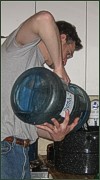 March 16: Water prep—what an ordeal! Our osmosis filter wasn’t able to crank out enough water for the brew (about 18 gallons) in 24 hours, so I had to buy 10 gallons at the hardware store. But when I attempted to adjust the pH for the sparge water, it came out way too low. Either there was something weird about the new lactic acid I bought, or the water was closer to neutral (most drinking water is quite alkaline).
March 16: Water prep—what an ordeal! Our osmosis filter wasn’t able to crank out enough water for the brew (about 18 gallons) in 24 hours, so I had to buy 10 gallons at the hardware store. But when I attempted to adjust the pH for the sparge water, it came out way too low. Either there was something weird about the new lactic acid I bought, or the water was closer to neutral (most drinking water is quite alkaline).
I had to run out to Jewel at 10:30 p.m. to buy another 10 gallons of water. But this stuff was so alkaline that I ended up using only half of it, along with 5 of the too-acidic stuff, and even then I had to add lactic acid—even more of it than I had added to the original water. Go figure. Went to bed much later than planned, but with all the water —and the rest of the gear—ready to rock in the morning.
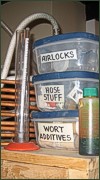 Why all this hassling with pH, you ask? I answer: Sparge water that’s too alkaline is less effective at “rinsing” the converted sugars out of the mash; and since this is the one and only purpose of sparge water, the homebrewer does well to adjust his sparge water to about 5.5 pH.
Why all this hassling with pH, you ask? I answer: Sparge water that’s too alkaline is less effective at “rinsing” the converted sugars out of the mash; and since this is the one and only purpose of sparge water, the homebrewer does well to adjust his sparge water to about 5.5 pH.
But why—you ask further, O Elephant’s Child—does a lower pH help the sparge water to work better? I answer only that I received a “B” in high school chemistry, thanks only to state-mandated standardized testing (at which I excel—unlike actual chemistry), which astonished (and I think disgruntled) my chem teacher—a miracle of science, much like the effect of low pH on sparge water.
March 17: Brew day. I’m gratified to be brewing beer for Pascha on the Feast of Our Holy Father Patrick, Enlightener of Ireland. Up at 7:30, immediately cranked on the gas for 7.5 gallons of mash water and a kettle to strike the mash tun before mash-in.
7:38 a.m. Fires up on the mash water and mash tun preheating water.
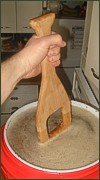 7:48 a.m. Strike the mash tun with a teakettle-full of boiling water to preheat it. Crank the gas on for 7 gallons of sparge water (out of ten total).
7:48 a.m. Strike the mash tun with a teakettle-full of boiling water to preheat it. Crank the gas on for 7 gallons of sparge water (out of ten total).
9:00 a.m. Mash in. Yes, it takes more than an hour for 7.5 gallons of water to reach 172°F. Grain bill below; mash at 154°F.
9:15 a.m. Transfer sparge water, now at 195°F, to lauter tun. Hose got stuck under the tun while raising up on the brew tower; drain tube got twisted up, clamp opened and a small leaks sprung at the drain spout; repaired adequately with Water Weld.
9:40 a.m. Iodine test confirms conversion is complete. However, remaining 3 gallons of sparge water need to be heated up; let mash rest for 10 minutes.
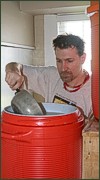 9:55 a.m. Transfer the rest of the sparge water to the lauter tun. Open valve on mash tun and begin the sparge; looking for clear runnings.
9:55 a.m. Transfer the rest of the sparge water to the lauter tun. Open valve on mash tun and begin the sparge; looking for clear runnings.
10:10 a.m. Running clear. Transfered run-off back into mash tun, set up the kettles and began run-off into them, with low heat.
10:25 a.m. Hark! I did not actually turn the burners on under the kettles! Cranked all four of them (two under each kettle) on high.
And by the way, yes, I’m wearing a sort of necklace in that picture of the mash recirculation. My daughter Ada (just turned four) wanted to see if it would fit me. She was delighted—beyond all proportion—that it did, and so I left it on.
 10:52 a.m. Sparge complete. That’s a rather quick sparge; ideally I’d shoot for 90 minutes. Ç’est la vie. We’ll see what our yield is.
10:52 a.m. Sparge complete. That’s a rather quick sparge; ideally I’d shoot for 90 minutes. Ç’est la vie. We’ll see what our yield is.
11:00 a.m. Take runnings from each kettle (equal parts) and add to pyrex cup measure and place in fridge to cool for gravity reading.
11:15 a.m. Boil begins in Kettle 1 (Pascha Ale); first hop addition.
11:20 a.m. Boil begins in Kettle 2 (St Thomas IPA); first hop addition. The name for this beer was suggested by my pal John who stopped by just in time to behold the pitching of yeast into this wort. I speculated this higher gravity beer—just within the range for an India Pale Ale—wouldn’t be ready until a week after Pasca. “Thomas Sunday,” John noted. Just as Thomas traveled to India to bring the Faith, so did IPA travel to India with the British fleet to bring beer goodness.
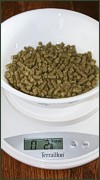 11:30 a.m. Take gravity reading from runnings. Comes in at a disgraceful 1.035 (22.4 pts!). Decide to try taking another reading.
11:30 a.m. Take gravity reading from runnings. Comes in at a disgraceful 1.035 (22.4 pts!). Decide to try taking another reading.
11:40 a.m. New gravity reading comes out at 1.049—quite good and much more like what I’d expect. That calculates to 31.5 points of gravity per pound of grain. Jubilation! I’ll check the reading again at a lower temperature (gravity reading here is adjusted for high temp). Not sure what went wrong on the first reading—maybe didn’t stir kettles enough before taking runnings (leaving thicker stuff on the bottom). Update: I’m nearly certain that the problem with the first reading was that I was looking at the “Balling” scale on my hydrometer, not the “Specific Gravity” scale. Doh!
12:00 p.m. Second hop addition to Kettle 1.
12:05 p.m. Second hop addition to Kettle 2.
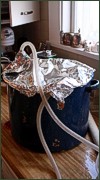 12:15 p.m. Third hop addition to Kettle 1. Also added Irish moss and sunk the wort chiller in there for sanitizing.
12:15 p.m. Third hop addition to Kettle 1. Also added Irish moss and sunk the wort chiller in there for sanitizing.
12:20 p.m. Third hop addition to Kettle 2, plus Irish moss.
12:30 p.m. Knock-off, Kettle 1: fourth hop addition, cover with foil.
12:35 p.m. Knock-off, Kettle 2: fourth hop addition, cover with foil.
12:50 p.m. Begin running cold water through wort chiller in Kettle 1.
 1:30 p.m. Cut off chiller and transfer to Kettle 2. Transfer wort to sanitized Fermenter 1 with a sanitized pot (makes lots of aerating bubbles).
1:30 p.m. Cut off chiller and transfer to Kettle 2. Transfer wort to sanitized Fermenter 1 with a sanitized pot (makes lots of aerating bubbles).
1:45 p.m. Pitch starter of yeast into Fermenter 1. Temperature approximately 76°F (thermometer got wet and couldn’t be restarted, but last reading before that was 77°F). Aerated with O2 for a couple minutes (should’ve been one minute). O.G. 1.053.
2:15 p.m. Pitch starter of yeast into Fermenter 2. Temperature 72°F. Aerated with O2. O.G. 1.056.
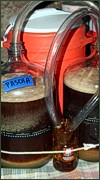 4:35 p.m. Clean up complete (delayed to socialize with pal John who stopped by to observe the brew-in-progress).
4:35 p.m. Clean up complete (delayed to socialize with pal John who stopped by to observe the brew-in-progress).
March 18: AM—Fermentation vigorous: thick foam, swirling wort, belching blow-off tubes. Temperature in fermenters down to about 66°F, which is how I like it. Nice and cool and the yeast takes its time. This is, I think, one of the most overlooked factor in brewing good beer. You can ferment the beer out pretty fast at 75°F, maybe a couple days, but it just won’t be as clean. “Haste makes waste,” whether you’re a homebrewer or a yeast cell.
March 20: Removed the blow-off tubes and fitted the fermenters with airlocks. Fermentation is still chugging along steadily. The former boiler room in which the fermenters are stored smells wonderfully hoppy and carbonous.
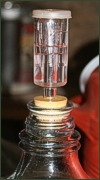 March 21: Fermentation is slowing down in Fermenter 1 (Pascha Ale), but still enough bubbles per minute to wait until at least tomorrow to rack to the secondary. Fermentation is still rather vigorous in Fermenter 2 (St. Thomas IPA), with yeast swirling all around and making the color much lighter and murkier than the other.
March 21: Fermentation is slowing down in Fermenter 1 (Pascha Ale), but still enough bubbles per minute to wait until at least tomorrow to rack to the secondary. Fermentation is still rather vigorous in Fermenter 2 (St. Thomas IPA), with yeast swirling all around and making the color much lighter and murkier than the other.
March 23: AM—Racked the Pascha Ale to the secondary. Gravity 1.015—not bad, but I could stand to lose another point or two (usually do lose at least one point in the secondary). The St. Thomas is still going, and rather cloudy. I recall that the second beer to be cooled and pitched last time was cloudier in the end, and I begin to wonder if it isn’t a matter of the second one not getting as good a cold break. But it’s still too early to tell with this brew; we’ll see how it looks out of the keg.
March 24: PM—Racked the St. Thomas IPA to the secondary. Gravity 1.016. Airlock was still active at racking, so I’m hopeful for a couple points off yet.
Additional notes will follow as fermentation progresses, and the recipes below will be filled in until complete.
The Recipes
Grain Bill (Double Batch)
- 10# U.S. 2-Row Pale Malt
- 10# U.S. Munich Malt (10 Lovibond)
- 2# U.S. Caramel Malt (20 Lovibond)
- 8 oz. U.S. Flaked Wheat
Mash & Sparge (Double Batch)
- Mash in a 10-gal. cap. water cooler, preheated with boiling water
- Mash with 7.5 gal. water plus 1T gypsum
- Strike temp. 172°F, mash temp. 154°F for 55 min.
- Sparge for 60 min. with 10 gal. water at 5.5 pH, 190°F)
- Yeild: 14.25 gal. at 1.049 S.G. (31.7 pts.)
- Mash split equally between two kettles
Boil—Pascha Ale
- 75 minute boil
- 2.375 oz. N. Brewer (6.5% AA) at 75 min.
- 1 oz. Liberty (3.6% AA) at 30 min.
- 1 oz. Liberty (3.6% AA) at 15 min.
- 1 T Irish moss at 15 min.
- 1 oz. Liberty (3.6% AA) at knockout
Boil—St Thomas IPA
- 75 minute boil
- 2.375 oz. N. Brewer (6.5% AA) at 75 min.
- 1 oz. Willamette (4.5% AA) at 30 min.
- 1 oz. Willamette (4.5% AA) at 15 min.
- 1 T Irish moss at 15 min.
- 1 oz. Willamette (4.5% AA) at knockout
Fermentation—Pascha Ale
- O.G. 1.053 (approx. 5.5 gal)
- Pitch Wyeast 1056 starter at 69°F (a bit low)
- Rack to secondary at 6 days (S.G. 1.015)
- Add 1 oz. Liberty (3.6% AA) dry hop at racking
- Keg at __ days (___ lbs. CO2 at __°F)
- F.G. 1.0__ (_._% ABV; apparent attenuation __%)
Fermentation—St Thomas IPA
- O.G. 1.056 (approx. 5.5 gal)
- Pitched Wyeast 1056 yeast starter at 72°F
- Rack to secondary at 7 days (S.G. 1.016)
- Add 1 oz. Liberty (4.5% AA) dry hop at racking
- Keg at __ days (___ lbs. CO2 at __°F)
- F.G. 1.0__ (_._% ABV; apparent attenuation __%)


Ever considered just making a simple kvass? =P
Comment posted March 17th, 2007 at 10:38 pm
Beer nerd.
Comment posted March 18th, 2007 at 3:43 pm
Eric, you lookin’ oooooooold, man!
all that beer.
;o)
Comment posted March 20th, 2007 at 12:34 pm
i’ve just now read this post, rather than look at the pictures, which is what i did 1st time.
its actually the funniest post you’ve written. well done!
‘belching blow-off tubes’ – i love it!
‘open valve on mash tun and begin the sparge’ aye aye cap’n, ooar oooar!
wonderful stuff
and very enlightening.
Comment posted March 21st, 2007 at 5:45 pm